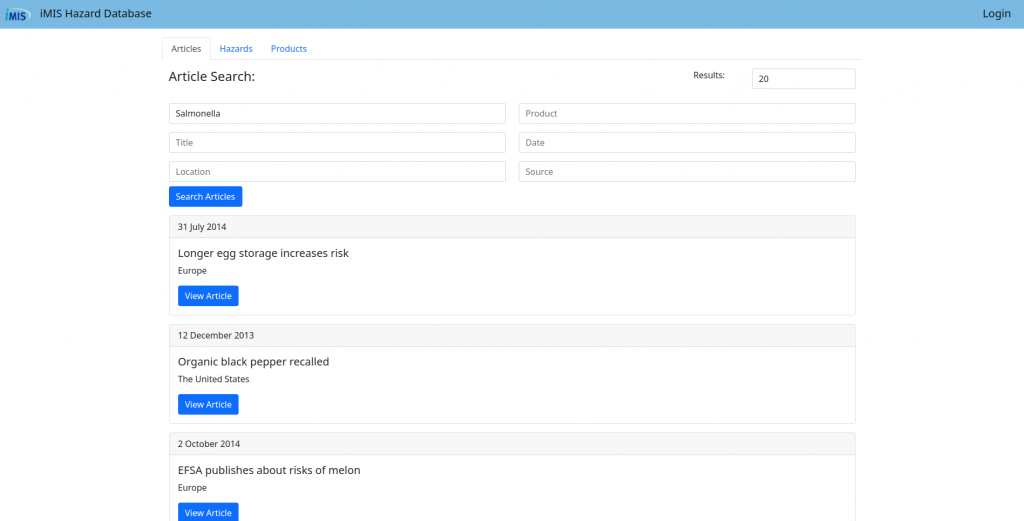GFSI approved standards
- BRC Global Food Standard.
- SQF 2000 level 2.
- International Food Standard (IFS).
- FSSC 22000.
In the field of food safety, these standards have been assessed by the GFSI on the basis of three elements.
- The presence of food safety management systems.
- The presence of codes of good practice (eg distribution).
- Working according to the principles of HACCP.
- More information about the individual standards click here
HACCP
HACCP stands for Hazard Analysis and Critical Control Points and is aimed at guaranteeing the safety of a food. When processing food, all kinds of things can go wrong, endangering the safety of the food. Companies that produce or process food must have insight into the possible risks that can occur. These risks must be described in a food safety plan, which is part of the HACCP plan. All food processors are obliged to draw up a HACCP plan. HACCP is subject to European legislation.
Content HACCP
With HACCP, a company checks the entire production process for possible food safety hazards. For each product, all stages of the production process, from raw material to consumption, are systematically subjected to a critical look. The possible dangers are mentioned. It must then be indicated how risks associated with these hazards are managed. The words Hazard Analysis and Critical Control Points stand for the following:
Hazard: A ‘hazard’ is a hazard that can be present in a product and subsequently pose a threat to the health of the consumer. This concerns:
- Microbiological hazards: bacteria, fungi, viruses and parasites.
- Chemical hazards (harmful substances): dioxins, heavy metals, pesticide residues, etc.
- Physical hazards: glass, hard plastic, wood or metal particles, etc.
Analysis: Analysis stands for analyzing the possible dangers present. An assessment must be made of the risk. The risk is a combination of the probability of the hazard and the seriousness of the health consequences if this were to happen.
Critical Control Points: Critical Control Points (CCPs) are the critical control points. These are points in the process that, if insufficiently controlled, can lead to disease or other consequences for public health. So they must be kept under control to avoid any danger. Possible CCPs include cooking, refrigeration and the prevention of cross-contamination.
In addition to the CCPs, there is often also talk of Quality Control Points (QCPs) and Legal Control Points (LCP).
Quality Control Points: quality control points are steps in the production process, which, if not adequately controlled, can lead to bad or spoiled products. No direct danger to public health, but the possibility of customer complaints and even recalls.
Legal Control Points (legal requirements): legal requirements are the requirements that are laid down in law and must therefore also be controlled. This can be compared to driving 50 km in built-up areas. These requirements do not have to lead to illness or spoiled products, but failure to comply with these legal requirements will lead to problems with the VWA and problems with audits.
In order to comply with the CCPs, QCPs and legal requirements (LCPs), the quality service has set up procedures, instructions and registration forms. Failure to perform the procedures can lead to illness or even worse. However, it can also lead to spoiled products among the customers. Or to problems with the VWA and the certifying institution.
It is therefore important that everyone is well aware of the HACCP and that it is properly recorded.
HACCP plan
A company that produces, processes or distributes foodstuffs must have a HACCP certificate. An important process in HACCP is a HACCP plan. This is included in the Commodities Act. The HACCP plan is also known as a food safety plan. The plan can be developed by the entrepreneur himself. This plan should be developed according to certain guidelines. The plan focuses in particular on analyzing hazards and dealing with critical control points.
The plan should include topics such as hygiene standards for food processing and storage. All regulations of the Commodities Act must also be included in the plan. These can be general regulations, such as wearing clean clothes and good hand care.
The seven phases in the HACCP plan
The food safety plan consists of seven phases. The intention of these phases is to identify, evaluate and verify food safety hazards.
Phases of the HACCP plan:
- Inventory of hazards (Hazards).
- Determining critical points (Critical Control Points).
- Determining standards with regard to critical control points.
- Designing a control system for control points.
- Develop a procedure to correct any deviations.
- Design a method for documentation of information and procedures.
- Developing verification procedures.
The aim of the food safety plan is to guarantee the safety of food. Consumer health is central to this entire process. The HACCP plan partly ensures that visitors to a restaurant can eat there with peace of mind. All seven phases have been developed for this purpose. Each step in this process is crucial and must be handled carefully.
The advantages of a HACCP plan
Working with a HACCP plan has a number of advantages. The chance of contamination by bacteria is reduced and you increase the safety of the food. If contamination does occur, in most cases you will not be held liable for the damage suffered. The production process is also examined. Inefficient processes often come to the fore. These processes can then be improved.
HACCP Hygiene Code
What is a hygiene code?
The hygiene code was created because it is essential to work hygienically. There are different hygiene codes. A hygiene code can be different per sector or even per company. A hygiene code can be seen as a reference work. It contains methods to guarantee the food safety of products. The hygiene code contains practical descriptions about handling hygiene. The hygiene code is based on HACCP.
Which hygiene codes are there?
There is a hygiene code for every industry. The best-known hygiene code is that of the catering industry, because many people come into contact with it. But there are also hygiene codes for the transport, storage and distribution of foodstuffs. Inland shipping also has its own hygiene code.
Maintaining a hygiene code
The hygiene code is enforced by the Food and Consumer Product Safety Authority. Safe and healthy food, safe products and healthy animals are central to this organisation. They look after food safety, product safety, alcohol and tobacco, animal diseases and welfare. They can issue fines if it is found that the hygiene code is not being followed. The checks are not announced in advance.
BRC (GFSI Approved)
BRC stands for British Retail Consortium. This is a branch organization for major UK supermarkets such as Tesco, Safeway, Somerfield, Sainsbury. This trade association developed the BRC Global Standard for Food Safety in 1998. The idea behind this is that a supplier with a certificate meets the requirements of different customers, thus limiting the flow of auditors. BRC is a food safety system that includes a prerequisite program, a HACCP system and a quality management system.
The BRC scheme consists of an inspection protocol and a technical standard. The inspection protocol is intended for inspecting institutions. The technical standard is an extensive checklist (with more than 300 points), in which all requirements for suppliers and products of food are stated.
With a BRC audit, a company can meet 4 scores, namely A, B, C or D. It depends on the number of deviations that a company is called during an audit which score is assigned to the company. If a company achieves score A or B, the audit frequency is 12 months, if a company achieves score C, the audit frequency is 6 months and with score D, the certification is not awarded.
IFS (GFSI Approved)
IFS stands for International Food Standard and bears a strong resemblance to BRC. The first variant of IFS is also based on the then current variant of BRC. However, there are some differences. Within IFS, four so-called ‘knock-out criteria’ are used. If one of these criteria is not met, the supplier is automatically not approved for IFS. The KO criteria are:
- control of critical control points;
- involvement of management and employees;
- traceability of products, raw materials and packaging materials;
- implementation of corrective measures.
The guidelines of IFS and BRC are broadly (approximately 85%) similar. As can also be seen from the above, the major difference lies in the way of assessing the criteria from the standard. This also determines the outcome of the audit: approved or not. An important difference here is that BRC has the opportunity to influence the outcome of the audit. The company has 28 days to provide evidence that the identified shortcoming has been adequately addressed. This option is clearly not offered within IFS: the result of the audit is the final result of the assessment. The frequency of the audits is determined by the achieved result and the risk class of the product.
ISO 22000
The International Organization for Standardization (ISO ) published a new standard on September 1, 2005: “ISO 22000 Food Safety Management Systems – Requirements for an Organization in the Food Chain”. After the general ISO standard for quality (ISO 9001:2000) and the ISO standard for the environment (ISO 14001), there is now also the ISO standard that can be used for food safety control, ISO 22000:2005.
This ISO standard has been developed with the aim of putting a food safety standard on the market that can be accepted worldwide.
ISO 22000 is applicable to the entire food chain, including suppliers. This means from the primary sector (producers) to the retailers. The standard can also be used by suppliers such as cold stores, transport companies, machine builders and producers of packaging materials.
The big difference between ISO 22000 and, for example, the BRC and IFS, is that there is no checklist that states exactly what what is and what is not accepted (as is the case with BRC/IFS). The ISO 22000 standard leaves more room for interpretation and individual insight, as is also the case with the HACCP standard. Certain risks can be excluded by means of well-substantiated arguments in the HACCP analysis. In this way a practical and workable system can be created for every company.
FSSC 22000 (GFSI Approved)
Since 2010 we have had the FSSC 22000 standard. FSSC stands for Food Safety System Certification 22000 and consists of the ISO 22000 standard where the basic requirements program is replaced by PAS 220. The PAS 220 contains the same points as the Codex, only the points that belong together are grouped. This provides clarity and overview. The FSSC 22000 standard is a complete certification scheme for a food safety management system. Food manufacturers already certified to ISO 22000 can comply with the FSSC 22000 scheme through an additional PAS 220 / ISO /TS 22002-1 audit. The standard does not replace standards such as HACCP or ISO-22000. Because the basis of FSSC is ISO-22000, the structure of the standard is the same as that of the other ISO standards (eg 9001 / 14001), which makes it easier to integrate these standards into one management system.
Related articles to GFSI: What are examples for Food safety standards?
Many customers and visitors to this page 'GFSI: What are examples for Food safety standards?' also viewed the articles and manuals listed below:



